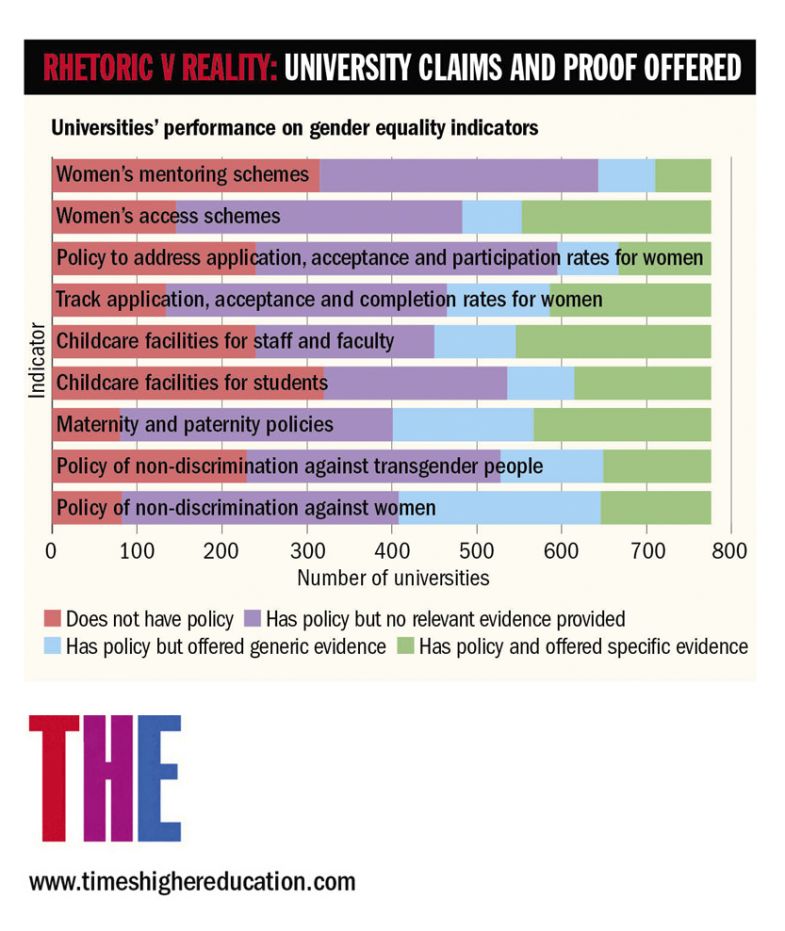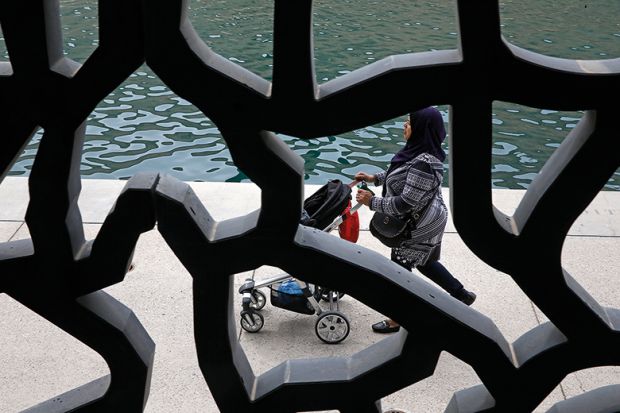Read the THE Unesco-IESALC report, Gender Equality: How global universities are performing
Most global universities are unable to provide information about their policies and services that support women’s advancement, according to a new Times Higher Education report that raises questions about the sector’s progress towards gender equality.
More than 750 universities across the world submitted data relating to the United Nations’ Sustainable Development Goal focusing on gender equality (SDG 5) for the latest THE Impact Rankings, and most of those institutions claimed that they had various policies and services that contribute to that goal, such as a policy of non-discrimination against women and provision of women’s access schemes.
However, the share able to supply relevant evidence of such initiatives was below 50 per cent in all cases.

Universities were asked to supply evidence for 12 indicators on gender equality. The most poorly supported indicators were those regarding the existence of women’s mentoring schemes for enrolled students and a policy to address female student enrolment. While 59 per cent and 69 per cent of institutions, respectively, said they were undertaking those activities, less than a quarter (17 per cent and 23 per cent, respectively) also presented evidence – and much of that evidence was deemed to be generic rather than specific to the question.
The areas where the most institutions provided evidence related to maternity and paternity policies and a policy of non-discrimination against women – codes that 90 per cent and 89 per cent of universities, respectively, said they had. But even in those cases, only 48 per cent and 47 per cent of institutions, respectively, also provided evidence (and just 27 per cent and 17 per cent presented specific evidence).
THE Campus views: Boosting female representation in STEM is crucial to global innovation
The rankings ask for evidence in part to assess whether the university community and the general public are, in the case of policies, able to hold an institution accountable for its commitments, and, in the case of services, aware of what is offered so they can access it.
Overall, universities in English-speaking countries tend to be more likely to submit evidence; they provided evidence in 75 per cent of cases, versus 38 per cent for other nations.
However, the report, published on International Women’s Day in partnership with the Unesco International Institute for Higher Education in Latin America and the Caribbean (IESALC), finds that there are also significant regional variations when it comes to which universities declared that they had certain policies and services.
The indicator with the highest variance across countries was a policy of non-discrimination against transgender people; just 14 per cent of universities in Iraq and 17 per cent of those in Iran said they had this, compared with 100 per cent of institutions in Australia, Italy and the UK. Not a single university in a Middle East country submitted specific evidence of such a policy.
The report says this reflects the fact that transgender rights are “a new frontier in the fight for gender equality that is only starting to emerge in some countries and is advancing slowly”.
Other regional discrepancies are perhaps more surprising. The nation with the lowest percentage of institutions providing childcare facilities to students is France, at just 15 per cent, compared with 100 per cent of Canadian and Australian institutions.
Overall, the report, Gender Equality: How global universities are performing, finds that universities in Oceania are furthest ahead in their commitment to gender equality.
Susanne Täuber, associate professor in the department of human resource management and organisational behaviour at the University of Groningen, said the findings reflected a “policy-practice gap”, meaning that while certain codes are ostensibly in place, they often are not yet being implemented across institutions or they are presented as “quick fixes” to issues rather than comprehensive, sustainable solutions. She added that the lack of evidence provided suggested that students and staff may be unaware of the existence of some gender-related policies and services.
“This is a huge problem because we have all the policies in place, we also have legislation in place; but it’s just not implemented in a cohesive way,” she said.
“Some women will benefit from some policies because, for instance, their line manager draws their attention to them or makes it happen. Other women will not be made aware of these policies.”
Dame Athene Donald, master of Churchill College, Cambridge, agreed that if universities were not providing evidence, it suggested that those policies were not being implemented.
“I can think of lots of examples where people [in universities] say, ‘We won’t tolerate bullying’, for instance. But where is it written down? How will you deal with it? I think things like that are still being codified,” she said.
ellie.bothwell@timeshighereducation.com
Join our webinar with Unesco-IESALC at 2pm GMT on 8 March for more analysis from the report and to hear from experts from five regions of the world about how their institutions are bringing about change. Register here.
A second report on the topic of gender equality will be published in May 2022, including a literature review, more recent data, more in-depth analysis and recommendations for universities.
POSTSCRIPT:
Print headline: Universities tout gender equality efforts but offer scant evidence
Register to continue
Why register?
- Registration is free and only takes a moment
- Once registered, you can read 3 articles a month
- Sign up for our newsletter
Subscribe
Or subscribe for unlimited access to:
- Unlimited access to news, views, insights & reviews
- Digital editions
- Digital access to THE’s university and college rankings analysis
Already registered or a current subscriber? Login









